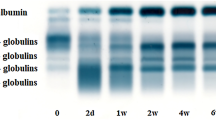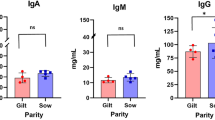Abstract
IN solving the problem whether γ-globulin lacking antibody properties exists and whether γ-globulin can be formed without an antigenic stimulus, our attention was focused on γ-globulin in piglets which had not been fed with colostrum1. The serum of piglets bred by a special technique without colostrum2 is very suitable material for these experiments, because the placenta of these animals does not permit the penetration of γ-globulin3, and the newborn animals lack this protein completely4–8. In our previous experiments1, however, the presence of a detectable amount of γ-globulin has been demonstrated after 100 times concentration of the γ-globulin fraction of the serum taken from the piglets bred under sterile conditions without colostrum for the first 14 days after birth ; at that time piglets are not yet able to produce antibodies, not even against an artificially injected antigen (Brucella suis) nor against antigens naturally present (E. coli strains). This γ-globulin cannot combine with any of the tested antigens and it could therefore be described as ‘normal’ γ-globulin. By injecting methionine labelled with sulphur-35 to piglets bred without colostrum it was found that this small amount of γ-globulin was not transmitted passively from the mother by the intra-uterine route, but that the γ-globulin of the young animals was synthesized de novo during the period when the piglets were not yet producing antibodies.
This is a preview of subscription content, access via your institution
Access options
Subscribe to this journal
Receive 51 print issues and online access
$199.00 per year
only $3.90 per issue
Buy this article
- Purchase on Springer Link
- Instant access to full article PDF
Prices may be subject to local taxes which are calculated during checkout
Similar content being viewed by others
References
Šterzl, J., Kostka, J., Říha, I., and Mandel, L., Folia microbiol., 5, 29 (1960).
Mandel, L., Lanc, A., and Syřínek, F., Zivocisna vyroba (Prague), 33, 37 (1960).
Brambell, F. W. R., Biol. Rev., 33, 488 (1958).
Earle, I. P., J. Agric. Res., 51, 479 (1935).
Jacobsen, P. E., and Moustgaard, J., Nord. Vet. Med., 2, 812 (1950).
Barrick, E. R., Matrone, G., and Osborne, J. C., Proc. Soc. Exp. Biol. Med., 87, 92 (1954).
Rutqvist, L., Amer. J. Vet. Res., 19, 25 (1958).
Lecce, J. G., and Matrone, G., J. Nutrition, 70, 13 (1960).
Fahey, J. L., and Horbett, A. P., J. Biol. Chem., 234, 2645 (1959).
Author information
Authors and Affiliations
Rights and permissions
About this article
Cite this article
FRANĚK, F., ŘÍHA, I. & ŠTERZL, J. Characteristics of γ-Globulin, lacking Antibody Properties, in New-born Pigs. Nature 189, 1020–1022 (1961). https://doi.org/10.1038/1891020a0
Issue Date:
DOI: https://doi.org/10.1038/1891020a0
This article is cited by
-
Polyclonal immunoglobulin response of thymic, hepatic and splenic lymphocytes from fetal, germ-free and conventionally reared pigs to different B-cell activators
Folia Microbiologica (1995)
-
Active synthesis of IgA in newborn precolostral piglets
Folia Microbiologica (1971)
-
Number of gammaglobulin containing cells after the single local administration of antigen
Folia Microbiologica (1969)
-
Isolation and characterisation of immunoglobulins in the serum of precolostral piglets
Folia Microbiologica (1969)
-
The sensitivity of smooth and rough mutants ofSalmonella typhimurium to bactericidal and bacteriolytic action of serum, lysozyme and to phagocytosis
Folia Microbiologica (1968)
Comments
By submitting a comment you agree to abide by our Terms and Community Guidelines. If you find something abusive or that does not comply with our terms or guidelines please flag it as inappropriate.



